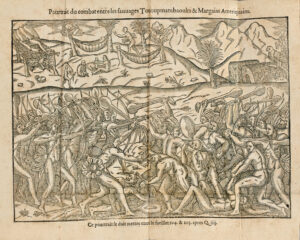N. p. [Geneva], pour les héritiers d’Eustache Vignon, 1594.
8vo of [180 x 105 mm] (22) ll., 382 pp., (6) ll., 8 full page plates and 1 large folding plate out of pagination, restoration in the whit margin of the lêf title, without affecting the text, a few ll. with light foxings. Contemporary overlapping vellum, flat spin with handwritten title lenghtwise, mottled edges. Contemporary binding.
Read more
The illustrated account of Lery’s travel to Brazil in 1556. He was one of the first Protestant colonizers in this country. Sabin 40151; Leclerc 2564; Field, An essay towards an Indian Bibliography, n°914 for the 1585 edition; Brunet, III, 1004; Chadenat 1658.
Jên de Léry and his companions left Geneva on the 10th of September 1556 and they boarded in Honfleur on the 19th of November. Lery spent one yêr in Brazil, making every effort to understand the natives’ customs, language and ceremonies.
“It has a high value as a historical work, being the results of a long experience among the savages of South America. In a bibliographical view, it is also not without merit, as it is uncommon, and brings a not inconsiderable price when offered for sale. The grêter portion of the work is composed of observations upon the peculiarities of the Indians” ( Field, An essay towards an Indian Bibliography, n°914).
Chapitre XX contains a very peculiar linguistic document « en langage sauvage et français ».
The very interesting illustration consists of 9 full-page woodcuts, including a folding one. These “very peculiar” figures (Chadenat) represent Indians, men or women, welcoming and funeral ceremonies like the mort of prisoner for a cannibalistic banquet…
The copy is complete with the extremely rare large folding plate, which is published here for the first time (240 x 194 mm).
Indeed the three previous editions, published between 1578 and 1585, did include this very sought-after engraving out of pagination. Bibliographers agree pointing the rarity of this print; thus it was missing to Garraux, and to the copy described by Chadenat (“the plate out of pagination is not bound here”). Field indicates that as for him: “the folding plate is lost in most copies”.
A precious wide-margined copy (height: 180 mm) preserved in its original overlapped vellum binding.
See less information

![Histoire d’un voyage fait en la terre du Brésil, Autrement dite Amérique. Contenant la navigation, et choses remarquables vues sur mer par l’autheur. Le comportement de Villegagnon en ce pays-là. Les mœurs & façons de vivre estranges des Sauvages Ameriquains : avec un Colloque de leur langage. Ensemble la description de plusieurs Animaux, Arbres, Herbes, & autres choses singulieres, & du tout inconnues par deçà […]. Reveue, corrigée et bien augmentée en cette troisième Edition, tant de figures, qu’autres choses notables sur le sujet de l’autheur.](https://www.camillesourget.com/wp-content/uploads/2023/03/Lery-pl.jpg)
![Histoire d’un voyage fait en la terre du Brésil, Autrement dite Amérique. Contenant la navigation, et choses remarquables vues sur mer par l’autheur. Le comportement de Villegagnon en ce pays-là. Les mœurs & façons de vivre estranges des Sauvages Ameriquains : avec un Colloque de leur langage. Ensemble la description de plusieurs Animaux, Arbres, Herbes, & autres choses singulieres, & du tout inconnues par deçà […]. Reveue, corrigée et bien augmentée en cette troisième Edition, tant de figures, qu’autres choses notables sur le sujet de l’autheur. - Image 2](https://www.camillesourget.com/wp-content/uploads/2023/03/titre-ccwxl.jpg)
![Histoire d’un voyage fait en la terre du Brésil, Autrement dite Amérique. Contenant la navigation, et choses remarquables vues sur mer par l’autheur. Le comportement de Villegagnon en ce pays-là. Les mœurs & façons de vivre estranges des Sauvages Ameriquains : avec un Colloque de leur langage. Ensemble la description de plusieurs Animaux, Arbres, Herbes, & autres choses singulieres, & du tout inconnues par deçà […]. Reveue, corrigée et bien augmentée en cette troisième Edition, tant de figures, qu’autres choses notables sur le sujet de l’autheur. - Image 3](https://www.camillesourget.com/wp-content/uploads/2023/03/016-a-bt131621-032-sou-rvb-hdef-cut-QnQLZ.jpg)
